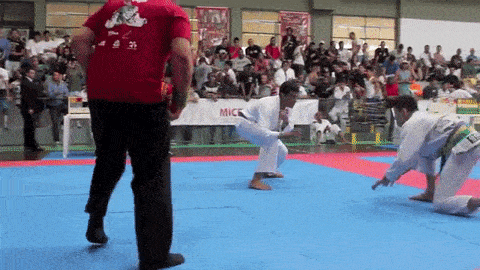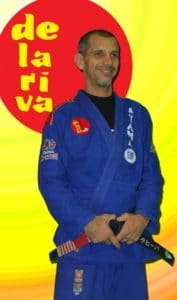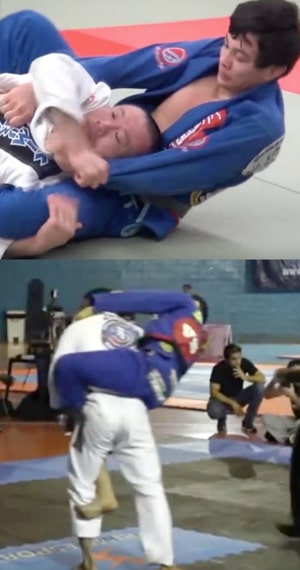by Jeff Meszaros
Every now and then, someone comes along who takes a sport by storm and revolutionizes the game by playing it differently…
The Gracies famously changed the world of martial arts by showing the importance of ground work. Wayne Gretzky changed hockey with his “go around the net” trick. Mike Tyson dominated boxing by using a “peekaboo” style that hadn’t been used like that before.
Jiu-jitsu has gone through a similar upheaval thanks to the twin brothers João and Paulo Miyao.
Since the Miyaos came on the scene a few years ago they’ve been responsible for the entire sport turning upside down; sometimes literally.
If you’re not familiar with them then here’s a fun video overview to get you started…
One of the keys to their success is having a very definite competition strategy.
They don’t do a million different throws, takedowns, sweeps, guard passes and submissions; instead they stick with a relatively simple gameplan that keeps the match exactly in their comfort zone.
That’s why they almost always go with their signature 5 step process for winning matches.
Let’s now go over their competition progression and break it down a little bit. Even if you don’t end up adopting their distinctive brand of jiu-jitsu it’s still a great lesson in how to build and follow a competition gameplan…
Step 1: Shoot, Grip & Sit
While they’ve had some success in other events, the two Miyao bothers got their start competing in IBJJF style events; where the rules allow pulling guard, but only after you’ve established a grip.
 So, what do the Miyao brothers do?
So, what do the Miyao brothers do?
They begin with a very, very low stance.
A stance so low and wide, it would be impossible for any opponent to get a takedown and the accompanying points.
Then, in one swift motion, they shoot in and grab their opponents on the lapel or sleeve while simultaneously sitting down to the open guard position.
Why do they do this?
To eliminate any chance of losing points to a more skilled wrestler or judo player with superior skills on the feet. Any time you’ve spent working on standing throws or takedowns goes right out the window.
If you’re fighting João or Paulo Miyao then where does this leave you? Exactly where they want you to be!
Now you’re facing their open sitting guard, the position they work on more than any other.
Unless you’ve been training three times a day preparing to pass this type of guard, there’s a good chance they’ll have you at a huge disadvantage immediately. Because they’ve been doing this position all day, every day for a long time
Step 2: Don’t Stand Up No Matter What
In mixed martial arts, a fighter sitting on the ground will be stood up if their standing opponent backs away from their guard. The fight between Ryan Hall and Gray Maynard in the UFC is a great example; it happened many times in that fight.
But under IBJJF rules, fighters are penalized for backing away from the guard so it’s the responsibility of standing fighters to pass the guard of their seated opponent.
This is why, once they sit down to their seated guard, the Miyao brothers do not ever stand up. Even if they have to butt-scoot towards their opponent endlessly, since standing back up would undo everything they accomplished by sitting down; putting them back on their feet and in position to be taken down or have an opponent pull guard on them.
Once they’ve gotten their open guard position, that’s where they stay until they can get to their next signature move.
Your self defense and MMA concerns notwithstanding, the following match between Paulo Miyao and Samir Chantre is a great example of how persistently the Miyaos uses this strategy.
In the video above, from 2:08 to 3:10 (i.e. from when Paulo first pulls guard to when he finally gets his grips) is essentially one long butt scooting session. Then more butt scooting happens at 5:02. And on top of that there are also many double guard pull situations in this match where both players are sitting on their butts, looking for the correct entanglement, and refusing to stand up.
Basically there’s a whole lot of refusing to stand up and sticking with the strategy he knows is effective for him no matter what!
From their butts they now they hunt for their favourite kind of guard: the de la Riva (see step 3, below)…
Step 3: Get the de la Riva Guard
 The next thing the Miyao brothers almost always go for is the De la Riva guard (the guard being used in the very top photo of this article).
The next thing the Miyao brothers almost always go for is the De la Riva guard (the guard being used in the very top photo of this article).
It’s a type of guard created a long time ago by Ricardo De la Riva, a man who was very much like the Miyao brothers.
He was small and thin, and had really flexible feet, and the guard he created was perfect for his body type; and theirs.
The guard that’s named after him involves weaving one of your legs behind one of your opponent’s legs and then up to hook in the front of their opposite thigh.
As BJJ has evolved this type of guard has gone from being a quirky position one competitor invented to being a mainstay of modern competition BJJ.
Part of the reason it’s so popular is because it gives you an option to control your opponent when he is standing up in your open guard (a topic which BJJ black belt and world champion Brandon Mullins explains very well in the video below).
When done correctly, it’s an excellent way to sweep your opponent or take their back. And it is a very hard guard to pass, especially in the gi.
The Miyao brothers use the de la Riva guard more than any other type of guard and attack relentlessly from it.
If their opponent tries to pass their de la Riva guard they switch to the reverse de la Riva which is a backwards version that also gives you many chances towards sweeping and moving to an opponent’s back.
The main goal from de la Riva guard for the Miyao brothers is to get their opponent’s backs, which they do with a variety of different techniques.
But there’s one specific way of taking the back, one method they’ve done over and over and over in competition, that they rely on above all else. And it’s covered in step 4 below…
Step 4: Go for the Berimbolo
There are many ways to move from the de la Riva guard to an opponent’s back…
From your de la Riva, you can use leg pressure to force an opponent to turn and then just hop around to their back…
Or from the reverse De la Riva, you can roll under your opponent and do a cool (and high percentage) move called “Kiss of the Dragon”.
The Miyao brothers are good at these methods (and many more) but there’s one technique above all others that they’re especially known for.
It’s called the ‘Berimbolo’ and it has spread throughout the jiu-jitsu world.
Before you get all confused by the spinning, inverting, upside down Berimbolo, first here’s a video that breaks this technique down into relatively simple steps…
Now, did the Miyao brothers invent the Berimbolo? No, it was created years before by someone else. Who was the first creator? That’s debatable – different people have claimed to be the inventor – and we’ll leave sorting the origin story of this technique for another day.
All controversy aside, there’s simply no doubt as to who put this move into the spotlight.
Back when they were just blue belts, the two Miyao brothers began berimbolo’ing all their opponents and the videos went viral, at least in the jiu-jitsu world. Soon, everyone was doing the berimbolo.
And it’s no wonder why, as it is a handy shortcut to get the back without having to pass your opponent’s guard. And it can be done when your opponent is standing, or when they are sitting. So it’s a versatile technique that puts you in the best position you could ask for.
How is it done? From De la Riva guard, you roll sideways and then, using the leverage of your legs, you force your opponent to roll with you, giving up the back position.
Here are two video breakdowns of the Miyao’s doing their signature techniques so you can watch to see them doing it over and over again.
Now most of the time the Miyao brothers use the Berimbolo to go to the back.
But since it’s such a central move in their game it’s important to point out that it can also can also lead directly into submissions, like the crazy inverting armbar attack that João shows below…
Now, on to what the Miyao’s do after they get to the back…
Step 5: Keep the Back Position and Apply the Sliding Lapel Choke
 What do you do once you’re at the top of the mountain? Simple enough, you stay there and try to finish the fight!
What do you do once you’re at the top of the mountain? Simple enough, you stay there and try to finish the fight!
And that’s what the two Miyao brothers do once they’ve reached the back.
Even if their opponent stands up they still hang on and look for their favourite submission from the back.
Now there are quite a few submissions from the back.
Some are very basic like the rear naked choke or the tried-and-true armbar.
A few submissions from the back are more recent, like the calf-crank, the banana split and the Ezequiel choke from the back.
But the Miyao brothers overwhelmingly prefer to do just one technique much more than any other; the sliding lapel choke.
How is it done?
Simple; Your first hand enters over your opponent’s shoulder, across their neck and into their collar while your other hand keeps ahold of their opposite lapel, under their armpit.
Then, by placing your other leg up around their shoulders, you’ve created a tight seal from which it is very hard for them to escape.
In the video below João Miyao uses this exact sliding lapel choke, augmented by the legs climbing over the arms, to finish yet another tough opponent…
This choke is very powerful because you’re able to push forward with your hips while pulling back on their lapel, creating an effect that results in their neck being squeezed in the ever-tightening loop of their gi. If they don’t tap and signal surrender, they’re going to be visiting dreamland pretty quickly.
The beauty of the choke is the fact that it lets you use the strength of your entire body against just the opponent’s neck.
Your entire weight just hangs off the loop that you’ve put around their neck, and any size or strength advantage that an opponent might have goes straight out the window.
This is why the Miyao brothers do it so well; as they are not the biggest or burliest men to step on the mat. But once they’ve caught you in a choke, they’re easily strong enough and heavy enough to force a surrender.
It’s physics and physiology combined to create a deadly effective finishing technique.
One More Miyao Highlight Video
Now that we’ve broken down the Miyao brother’s go-to competition gameplan here’s one more highlight video for you.
As you watch it see how many of the 5 elements we discussed above you can spot amidst all the leg flopping chaos!
A Bit More Jiu-Jitsu…
If you’re not already subscribed to the Grapplearts Newsletter then you may want to consider signing up…
Stephan Kesting uses it to send out BJJ related emails including links to articles like this, new technique videos, and training tips.
There is no cost; it’s 100% free and always will be.
Not only that, it’s also risk free. If you don’t like what you get you can easily unsubscribe with a single click by following the ‘manage your subscription’ link at the bottom of every email you’ll ever get from him.
Enter your email below to sign up and never miss another important article or update again!
The post The Miyao Brothers’ 5 Step BJJ Competition Strategy appeared first on Grapplearts.
